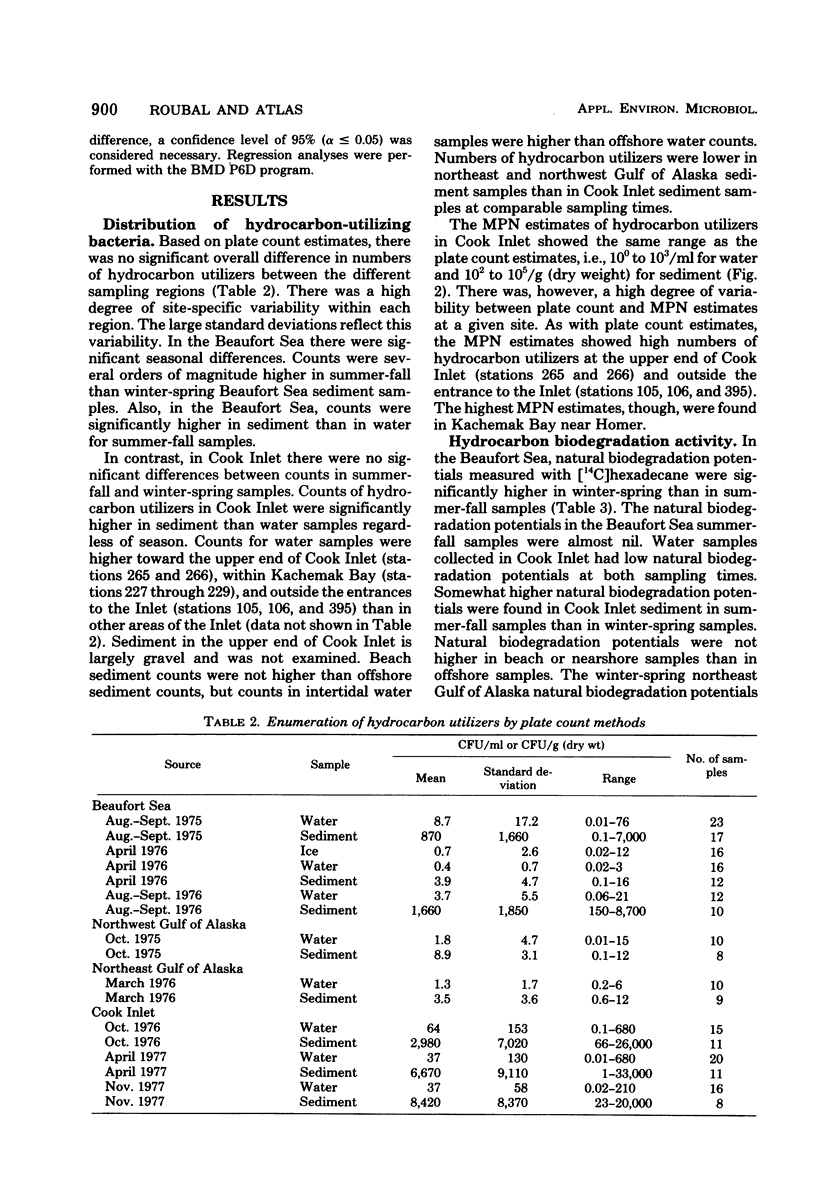Abstract
Hydrocarbon-utilizing microorganisms were enumerated from Alaskan continental shelf areas by using plate counts and a new most-probable-number procedure based on mineralization of 14C-labeled hydrocarbons. Hydrocarbon utilizers were ubiquitously distributed, with no significant overall concentration differences between sampling regions or between surface water and sediment samples. There were, however, significant seasonal differences in numbers of hydrocarbon utilizers. Distribution of hydrocarbon utilizers within Cook Inlet was positively correlated with occurrence of hydrocarbons in the environment. Hydrocarbon biodegradation potentials were measured by using 14C-radiolabeled hydrocarbon-spiked crude oil. There was no significant correlation between numbers of hydrocarbon utilizers and hydrocarbon biodegradation potentials. The biodegradation potentials showed large seasonal variations in the Beaufort Sea, probably due to seasonal depletion of available nutrients. Non-nutrient-limited biodegradation potentials followed the order hexadecane > naphthalene ≫ pristane > benzanthracene. In Cook Inlet, biodegradation potentials for hexadecane and naphthalene were dependent on availability of inorganic nutrients. Biodegradation potentials for pristane and benzanthracene were restricted, probably by resistance to attack by available enzymes in the indigenous population.
Full text
PDF








Selected References
These references are in PubMed. This may not be the complete list of references from this article.
- Horowitz A., Atlas R. M. Continuous open flow-through system as a model for oil degradation in the arctic ocean. Appl Environ Microbiol. 1977 Mar;33(3):647–653. doi: 10.1128/aem.33.3.647-653.1977. [DOI] [PMC free article] [PubMed] [Google Scholar]
- Schwarz J. R., Walder J. D., Colwell R. R. Deep-sea bacteria: growth and utilization of hydrocarbons at ambient and in situ pressure. Appl Microbiol. 1974 Dec;28(6):982–986. doi: 10.1128/am.28.6.982-986.1974. [DOI] [PMC free article] [PubMed] [Google Scholar]
- Sexstone A. J., Atlas R. M. Response of microbial populations in arctic tundra soils to crude oil. Can J Microbiol. 1977 Oct;23(10):1327–1333. doi: 10.1139/m77-201. [DOI] [PubMed] [Google Scholar]
- Walker J. D., Colwell R. R. Enumeration of petroleum-degrading microorganisms. Appl Environ Microbiol. 1976 Feb;31(2):198–207. doi: 10.1128/aem.31.2.198-207.1976. [DOI] [PMC free article] [PubMed] [Google Scholar]
- Walker J. D., Colwell R. R. Measuring the potential activity of hydrocarbon-degrading bacteria. Appl Environ Microbiol. 1976 Feb;31(2):189–197. doi: 10.1128/aem.31.2.189-197.1976. [DOI] [PMC free article] [PubMed] [Google Scholar]


